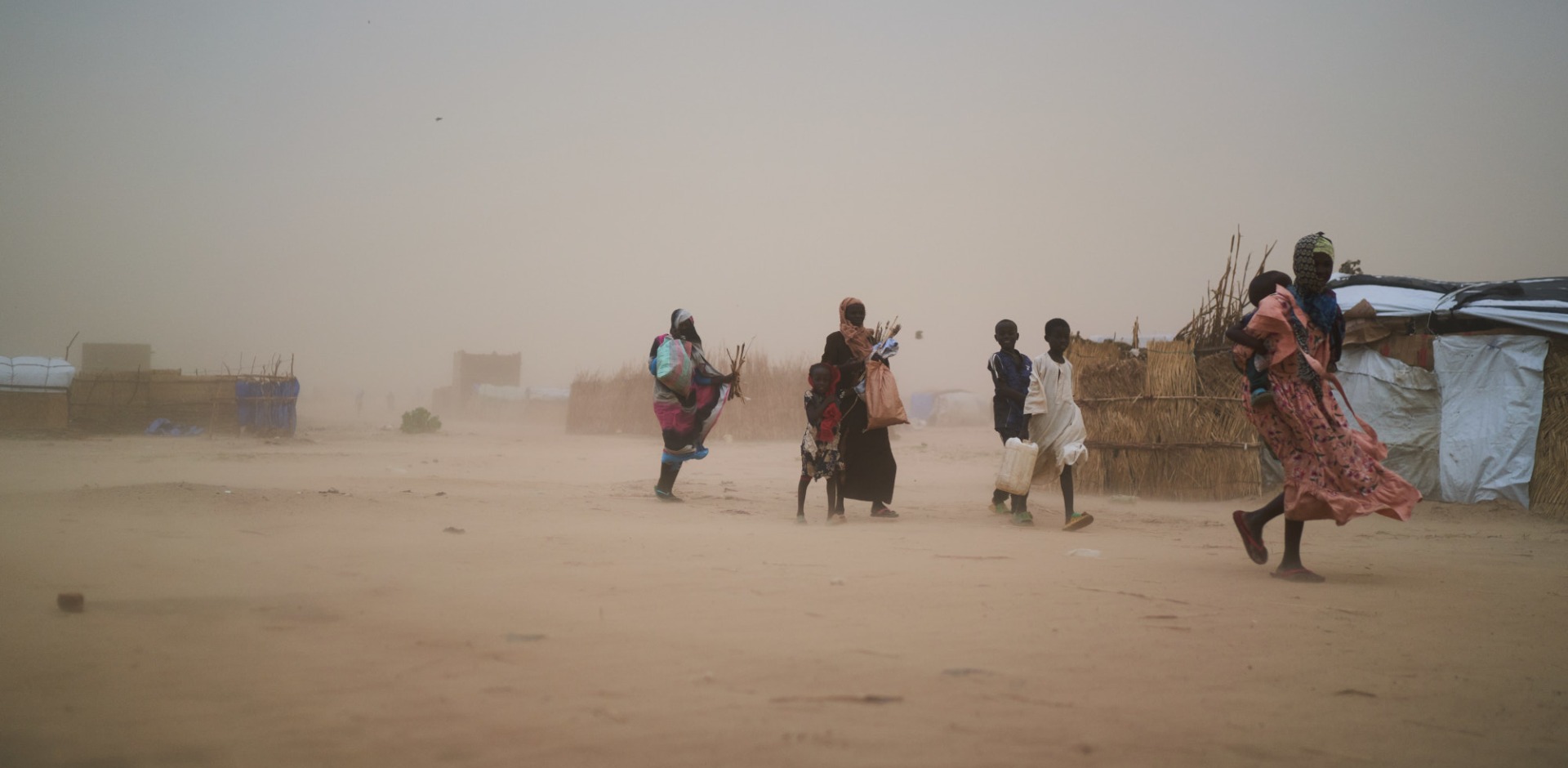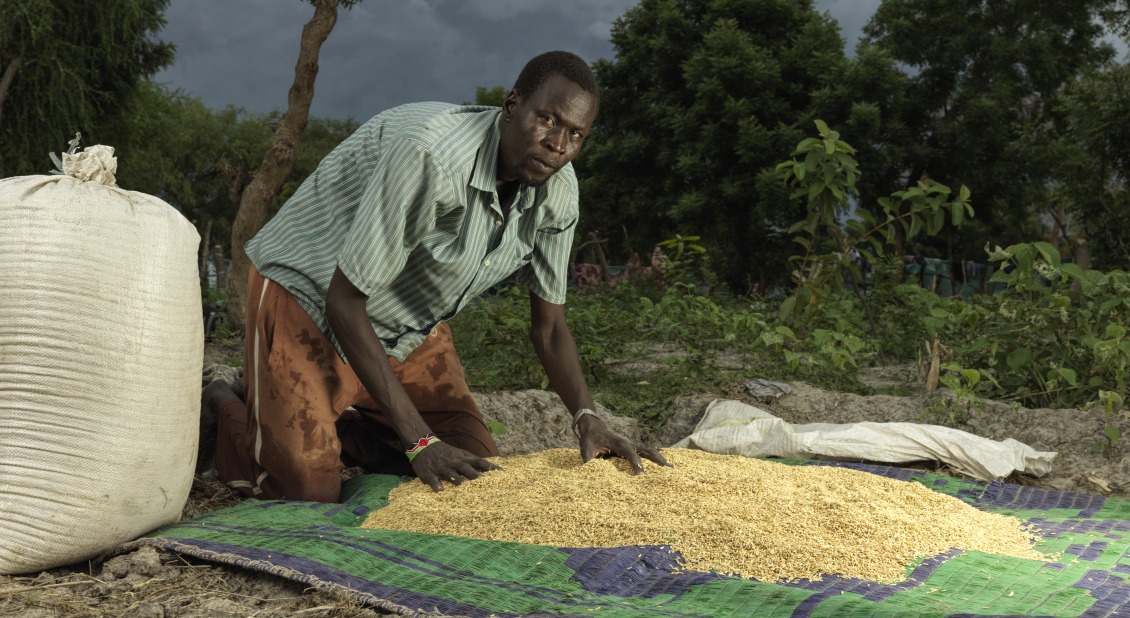
FAMINE IN SUDAN

After unprecedented flooding destroyed their homes, the small area of Paguir, South Sudan, became a refuge for hundreds of displaced families.
It’s been three years since the floods washed away fields across Jonglei State – three years since farmers have been able to plant seeds and harvest crops, leaving families hungry and facing severe malnutrition. Desperate, many resorted to eating water lilies.
Joe Joe Zubahyea was determined to help families find a solution. As Action Against Hunger’s Head of Base in Paguir, he is responsible for our implementing lifesaving projects in the area. Earlier this year, he introduced a new technique – one that made the most of the waters that had destroyed so many livelihoods: rice growing.
“The first challenge was to convince people that this is something that they could do,” says Joe Joe.
When I first started, people were saying, ‘Who is this person that Action Against Hunger brought who is planting grass?!’ Because for them, this was the first time seeing the rice plant.
Before long, Joe Joe’s work caused a domino effect. Residents carefully observed his planting and then mimicked it in their own plots. It was Joe Joe’s dream—that people would take the rice seed and begin planting it themselves, demonstrating both resiliency and self-sufficiency.

James Wuor, a 50-year-old farmer, was originally too shy to join Joe Joe’s planting team. Instead, he watched and waited outside of Action Against Hunger’s rice farm. After a month, his observations paid off — he was able to put his skills to use and plant the rice himself.
James began planting in his old garden, which had been ruined by the floods. He was amazed to see the rice quickly flourish in the flood waters.
“We normally grow sorghum and maize in a dry place,” he says. “When I saw the rice, it was growing in the water. [This] could sustain me for years since I don’t know when these floods will leave. I could grow this rice so that my children can eat until the time that God takes this water away from us.”
James is especially grateful because the rice farm didn’t cost anything to create. The rice grows in water — and water is everywhere, thanks to the floods.

Years of flooding have left the communities in South Sudan with little to no crops and few animals. With help from Action Against Hunger, a new crop grown in the floodwaters — rice — has transformed their lives.
Before long, the new way of farming caught on throughout Paquir. Although he initially doubted himself, 40-year-old Bol Gatkuoth patiently listened to Joe Joe’s teachings. He planted seedlings right in the flood water that had seeped onto his land.
Today, his rice farm is bountiful and lusciously green. He even invented a way to keep pesky birds away by cutting straw and separating the paddy grain from the cut crop. To Bol, the golden seeds of rice are a symbol of his success and a better future for Paguir.
“Rice is something new in this area,” says Bol. “This is something I had to learn so that I can adapt to the future…I took my time to go and watch because I knew that it was a way to survive the floods.”
Bol is filled with hope at the prospects of farming more rice.
When I harvested this rice, I saw the new seeds and I touched them. I felt immediately happy, the same as when I touched my sorghum and maize seeds. I feel proud, I can even have hope in the future.
Bol and James hope to expand their farms and soon, they’ll begin to train their neighbors to start farms of their own. The flooding continues without end across South Sudan, but the rice farmers of Paguir know that their creative spark will ignite a new movement, forever inspiring solidarity and togetherness.
Throughout her life, Nyaok Dieng grew maize and sorghum with her husband and children. But when the floods came, her family suffered. With seven mouths to feed, the high waters washed away all sources of food. To save her children, Nyaok learned to grow rice with Action Against Hunger.
“I’ll make my rice farm because rice grows in the flood,” says Nyaok. “I can make my plot, prepare it and use the skills that Action Against Hunger gave me.”
My family can benefit from this farm, but it will also be my own.
Joe Joe began teaching women like Nyaok to provide alternative farming methods to the community. Now, the rice farms are more than just plots of land — they are sustaining many women’s livelihoods.
For the first time, dozens of women own and cultivate their own farms. They are mastering the art of seed broadcasting, nursery preparation, transplantation, and harvesting. They are confident in themselves and their ability to grow — and they’ve learned a skill that could change life in Paguir for the better.

Many of the women of Paguir moved here because of the floods. Nyagai Malual arrived in September 2021 after desperately paddling for three days in a small canoe with her three children huddled behind her. In Paguir, she was struck by the thriving rice paddies — a crop she had never seen before.
Nyagai quickly realized what a huge opportunity that rice presented and joined the groundbreaking project as one of its first women participants. “God closed the option of growing sorghum and maize, but opened the option of rice,” she says.
Though the rice project has only been in Paguir for a short time, it’s already transformed the entire community.
“It’s hard work,” Nyagai says. “But even if we stay here from now until the evening, I won’t get tired because I need to have more experience. In the future, I’ll carry on this experience, and I’ll make something for myself.”

Join our community of supporters passionate about ending world hunger.